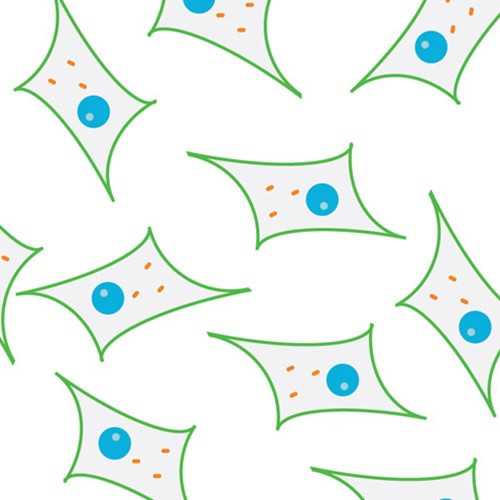Scomber scombrus Myoblast Cell Line (MACK1)
MACK1 (myoblast cell) is a continuous, adherent cell line derived from mature muscle of Atlantic mackerel (Scomber scombrus).
Highlights:
- Cell line is useful for cellular agriculture
- Cells progressed through a likely spontaneous immortalization crisis event, after which the cell doubling time decreased to ~30-35 hours
- PCR and Sanger Sequencing on the cells' genomic DNA confirmed cells' identity as Scomber scombrus
- Highly pure satellite cell population confirmed through Pax7 staining and efficient muscle differentiation
MACK1 is the first commercially available fish muscle cell line and can prove a valuable tool for studying marine cell culture. As Atlantic mackerel is a commonly consumed fish, the food-relevant cell line is especially valuable in cultivated seafood applications.
From the laboratory of David Kaplan, PhD, Tufts University Center for Cellular Agriculture (TUCCA).
MACK1 (myoblast cell) is a continuous, adherent cell line derived from mature muscle of Atlantic mackerel (Scomber scombrus).
Highlights:
- Cell line is useful for cellular agriculture
- Cells progressed through a likely spontaneous immortalization crisis event, after which the cell doubling time decreased to ~30-35 hours
- PCR and Sanger Sequencing on the cells' genomic DNA confirmed cells' identity as Scomber scombrus
- Highly pure satellite cell population confirmed through Pax7 staining and efficient muscle differentiation
MACK1 is the first commercially available fish muscle cell line and can prove a valuable tool for studying marine cell culture. As Atlantic mackerel is a commonly consumed fish, the food-relevant cell line is especially valuable in cultivated seafood applications.
From the laboratory of David Kaplan, PhD, Tufts University Center for Cellular Agriculture (TUCCA).
This product is for sale to Nonprofit customers only. For profit customers, please Contact Us for more information.
Specifications
| Product Type: | Cell Line |
| Name: | MACK1 |
| Cell Type: | Muscle cell line |
| Organism: | Atlantic mackerel |
| Source: | White muscle |
| Biosafety Level: | BSL-2 |
| Growth Conditions: |
Growth media formulation: Leibovitz's L-15 Medium with 20% fetal bovine serum (FBS), 20 mM HEPES pH7.4, 1 ng/mL FGF-2, 1% antibiotic-antimycotic. Recommend to add ECM mimetic, such as laminin (typically at 0.25 μg/cm2), (pre-coating or in media) to improve cell adhesion. Culture the cells at 27°C without CO2 in vented cell culture flasks. For reference, the providing lab uses the following type of incubator: Thermo Scientific Cat. No. 50125590 With the first thaw, plate all 1 million cells in the vial into a 25 cm2 tissue culture flask. Allow cells 1-2 days to recover before changing the medium. The high seeding density is necessary due to poor cell viability after freezing/thawing. See "DOCUMENTATION" section below. |
| Subculturing: |
Split with 0.05% or 0.25% trypsin-EDTA when cells reach 70-80% confluence. Recommended seeding density: 3,000-6,000 cells/cm2. It is further recommended to add ECM mimetic, such as laminin (typically at 0.25 μg/cm2), (pre-coating or in media) to improve cell adhesion. See "DOCUMENTATION" section below. |
| Cryopreservation: | Growth media with 10% DMSO (See "DOCUMENTATION" section below.) |
| Comments: |
Doubling time: ~30-35 hours.; For thawing cells, seed the cells in a T25 tissue culture flask. The high seeding density is necessary due to poor cell viability after freezing/thawing. NOTE: The cells are difficult to visualize on brightfield microscopy. Phase contrast is recommended. |
| Storage: | LN2 |
| Shipped: | Dry ice |
Documentation
Provider
From the laboratory of David Kaplan, PhD, Tufts University Center for Cellular Agriculture (TUCCA).
References
- Saad MK, Yuen JSK Jr, Joyce CM, et al. Continuous fish muscle cell line with capacity for myogenic and adipogenic-like phenotypes. Sci Rep. 2023;13(1):5098. Published 2023 Mar 29. doi:10.1038/s41598-023-31822-2
- Michael K Saad, John SK Yuen Jr, Connor M Joyce, Xinxin Li, Taehwan Lim, Talia L Wolfson, Justin Wu, Jason Laird, Sanjana Vissapragada, Olivia P Calkins, Adham Ali, David L Kaplan. Continuous Fish Muscle Cell Line with Capacity for Myogenic and Adipogenic-like Phenotypes. bioRxiv 2022.08.22.504874; doi: https://doi.org/10.1101/2022.08.22.504874
If you publish research with this product, please let us know so we can cite your paper.


